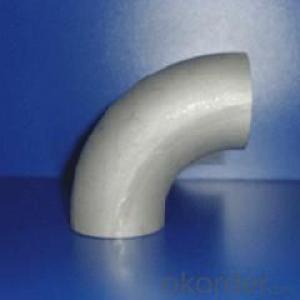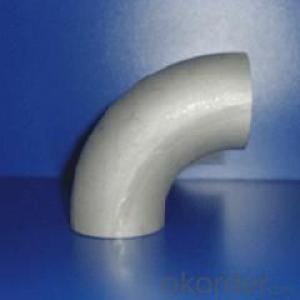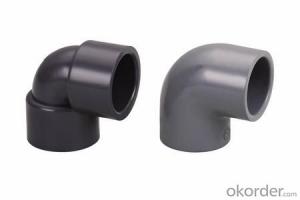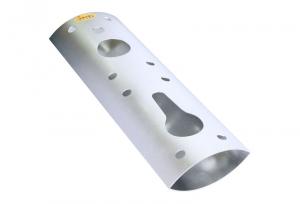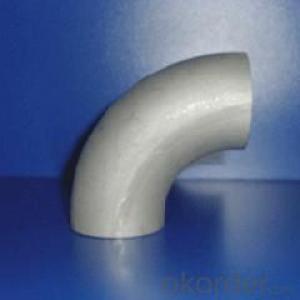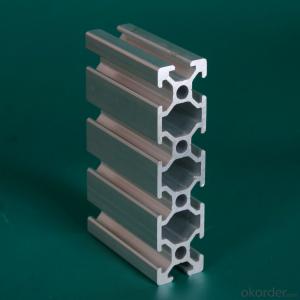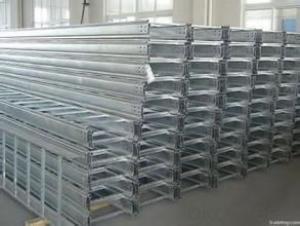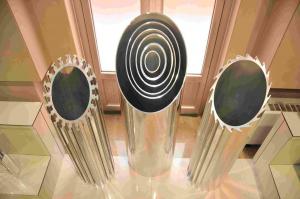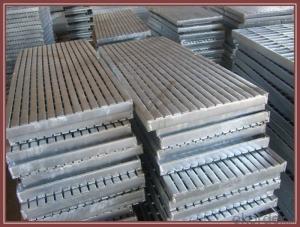45 Degree Aluminum Elbow - Aluminum Extrusion Profiles H Channel for Construction
- Loading Port:
- Shanghai
- Payment Terms:
- TT OR LC
- Min Order Qty:
- 6 m.t.
- Supply Capability:
- 1000 m.t./month
OKorder Service Pledge
OKorder Financial Service
You Might Also Like
Specifications
45 degree aluminum elbow:
Material : carbon steel , stainless steel and alloy steel,
45degree aluminum elbow
Specifications
ASTM B16.9 A234 WPB 90degree 1.5D carbon steel elbow
1.A234 WPB elbow
2.size:1/2"-72"
3.material:A234 WPB
4.API CE ISO
ASTM B16.9 A234 WPB 90degree 1.5D carbon steel elbow
1.A234 WPB elbow
2.size:1/2"-72"
3.material:A234 WPB
4.API CE ISO
Size | 1/2''-24 seamless elbow 26''-72''butt weld elbow |
Wall Thickness | SCH10-SCH160,STD,XS,XXS, GOST , DIN, JIS standard thickness |
Standard | ASTMA234,ASTM A420,ANSI B16.9/B16.28/B16.25,ASME B16.9, JIS B2311-1997/2312, JIS B2311/B2312, DIN 2605-1/2617/2615, GB 12459—99,GOST,EN Standard etc. |
Material | Q235, 20#, 10#, Q345 A234 WPB, WP5, WP9,WP11, ST37.0,ST35.8,ST37.2,ST35.4/8,ST42,ST45,ST52,ST52.4 STP G38,STP G42,STPT42,STB42,STS42,STPT49,STS49 |
Application | Low and middle pressure fluid pipeline,boiler, petroleum and natural gas industry,drilling,chemical industry, electric industry,shipbuilding, fertilizer equipment and pipeline, structure,petrochemical, pharmaceutical industry |
Surface | Sand blasting, black anti-rust oil or galvanized , 3PE,etc. |
Package | Seaworthy Package, Plastic film,Ptywood Wooden Cases or wooden pallet or |
Certificate | ISO9001:2008, CE, API , SGS,BV, etc |
Capacity | 50000tons/year |
Advantages | 1.Reasonable price with excellent quality 2.Abundant stock and prompt delivery 3.Rich supply and export experience, sincere service 4. Reliable forwarder, 2-hour away from port. |
- Q: How do aluminum profiles perform in terms of weather resistance?
- Aluminum profiles exhibit remarkable weather resistance due to the unique qualities of aluminum itself, such as its resistance to corrosion and ability to endure harsh environmental conditions. To enhance their weather resistance, aluminum profiles are typically coated or anodized, providing long-lasting durability and protection against different weather elements. The corrosion resistance of aluminum is especially advantageous for outdoor applications. When exposed to oxygen, aluminum naturally forms an oxide layer, serving as a protective barrier against rust and deterioration. Consequently, aluminum profiles are highly resistant to moisture, rain, and humidity, making them suitable for use in coastal areas or regions with high levels of precipitation. Moreover, aluminum profiles also possess resistance against UV radiation. The application of surface treatments, such as powder coating or anodizing, adds an extra layer of defense against the sun's harsh rays. Consequently, aluminum profiles do not fade, chip, or crack when exposed to prolonged sunlight, ensuring their original appearance and structural integrity are preserved over time. Concerning extreme weather conditions, aluminum profiles are specifically designed to withstand high winds, extreme temperatures, and even severe storms. They possess excellent mechanical properties, including high strength and stiffness, enabling them to bear heavy loads and resist deformation. As a result, aluminum profiles are ideal for applications in construction, architecture, and outdoor infrastructure projects where weather resistance is of utmost importance. In conclusion, aluminum profiles exhibit exceptional weather resistance. Their inherent corrosion resistance, combined with the availability of various surface treatments, ensures their ability to endure a wide range of weather conditions while maintaining their structural integrity and aesthetic appeal.
- Q: What tests do the aluminum profiles used in the curtain wall project do?
- Tensile properties, hardness, coating thickness
- Q: Can aluminum profiles be used in solar reflector systems?
- Yes, aluminum profiles can be used in solar reflector systems. Aluminum is a commonly used material in solar reflector systems due to its high reflectivity and excellent corrosion resistance. Aluminum profiles can be easily customized and shaped into various forms to optimize the reflection of sunlight onto the solar panels. Additionally, aluminum profiles are lightweight and durable, making them suitable for outdoor applications. Overall, aluminum profiles are an effective and efficient choice for solar reflector systems.
- Q: This question asks for the correct procedure to install aluminum profiles.
- <p>To install aluminum profiles correctly, follow these steps: 1. Measure and mark the positions where the profiles will be installed. 2. Clean the surfaces to ensure proper adhesion. 3. Use a suitable adhesive or mechanical fasteners recommended for aluminum. 4. Align the profile with the marked positions and secure it in place. 5. Check for level and plumb, and adjust as needed. 6. Wipe away any excess adhesive and clean the profile. 7. Allow the adhesive to cure according to the manufacturer's instructions. 8. Inspect the installation for any gaps or misalignments and make corrections if necessary. Always refer to the specific installation guidelines provided by the aluminum profile manufacturer for best results.</p>
- Q: How do you cut aluminum profiles?
- Aluminum profiles can be cut using various methods such as sawing, shearing, or using a CNC machine. The specific method chosen depends on the type and thickness of the aluminum profile, as well as the desired precision and finish.
- Q: Changhe brand aluminum can?
- Profile is not bad, but visibility is not too large, the whole is still very good, cost-effective
- Q: Are aluminum profiles suitable for automotive body panels?
- Yes, aluminum profiles are suitable for automotive body panels. Aluminum is a lightweight and durable material that has several advantages over traditional steel panels. It offers better fuel efficiency as it reduces the overall weight of the vehicle, leading to improved performance and lower emissions. Aluminum panels also have excellent corrosion resistance, which helps to prolong the lifespan of the vehicle. Moreover, aluminum is highly moldable and can be formed into complex shapes, making it suitable for creating the aerodynamic designs required in modern automotive styling. Additionally, aluminum is a recyclable material, aligning with the industry's growing focus on sustainability. However, it is important to note that aluminum panels may require specialized repair techniques compared to steel, and they can be more expensive to manufacture initially. Overall, the benefits of using aluminum profiles for automotive body panels outweigh the potential drawbacks, making them a suitable choice for modern vehicles.
- Q: Can aluminum profiles be used in green building projects?
- Green building projects can utilize aluminum profiles effectively. Aluminum, being an eco-friendly material, offers numerous advantages in the realm of green building. To begin with, aluminum's lightweight nature cuts down on transportation costs and energy consumption during construction. Furthermore, aluminum is entirely recyclable, ensuring that it can be reused indefinitely without any loss in quality. This characteristic makes aluminum an ideal option for green building projects as it aids in waste reduction and promotes a circular economy. Additionally, aluminum boasts a lengthy lifespan and necessitates minimal upkeep, further enhancing its sustainability. It is worth noting that aluminum profiles can easily be integrated with other green building materials like glass, enabling energy-efficient designs that maximize natural light and minimize the reliance on artificial lighting. In conclusion, aluminum profiles offer a sustainable and versatile choice for green building projects.
- Q: Can aluminum profiles be used for soundproofing?
- Aluminum profiles have the ability to offer some soundproofing benefits, although they may not provide the same level of sound reduction as specialized soundproofing materials like acoustic panels or insulation. These profiles are commonly used in the construction industry for various purposes, such as window frames and door frames. When incorporated into soundproofing applications, aluminum profiles can effectively minimize noise transmission through windows and doors. The lightweight and durable nature of aluminum makes it an ideal material for blocking or dampening sound waves. Its structural integrity allows for the creation of tight seals, resulting in reduced sound leakage and improved sound insulation. To further enhance soundproofing, aluminum profiles can be combined with other materials like rubber gaskets or weatherstripping. This combination enhances the sealing properties and contributes to better sound insulation. Additionally, the use of double or triple glazing with laminated glass in conjunction with aluminum profiles can provide even better sound insulation. However, it is important to consider that the effectiveness of aluminum profiles in soundproofing depends on various factors. These factors include the thickness and quality of the profiles, the design of the window or door system, and the overall construction of the building. In conclusion, while aluminum profiles can assist in reducing noise transmission through windows and doors, they should be viewed as part of a comprehensive soundproofing strategy rather than the sole solution.
- Q: Are aluminum profiles energy-efficient?
- Yes, aluminum profiles are considered to be energy-efficient. Aluminum is a highly conductive material, which means it can effectively transfer heat or cold. This property allows aluminum profiles to provide excellent thermal insulation, helping to minimize energy loss and maintain a consistent indoor temperature. Additionally, aluminum profiles can be designed with thermal breaks, which further enhance their energy efficiency by reducing heat transfer between the inside and outside of a building. These features make aluminum profiles a popular choice for windows, doors, and other building components, as they contribute to energy savings and reduce the overall carbon footprint of a structure.
Send your message to us
45 Degree Aluminum Elbow - Aluminum Extrusion Profiles H Channel for Construction
- Loading Port:
- Shanghai
- Payment Terms:
- TT OR LC
- Min Order Qty:
- 6 m.t.
- Supply Capability:
- 1000 m.t./month
OKorder Service Pledge
OKorder Financial Service
Similar products
Hot products
Hot Searches
Related keywords
